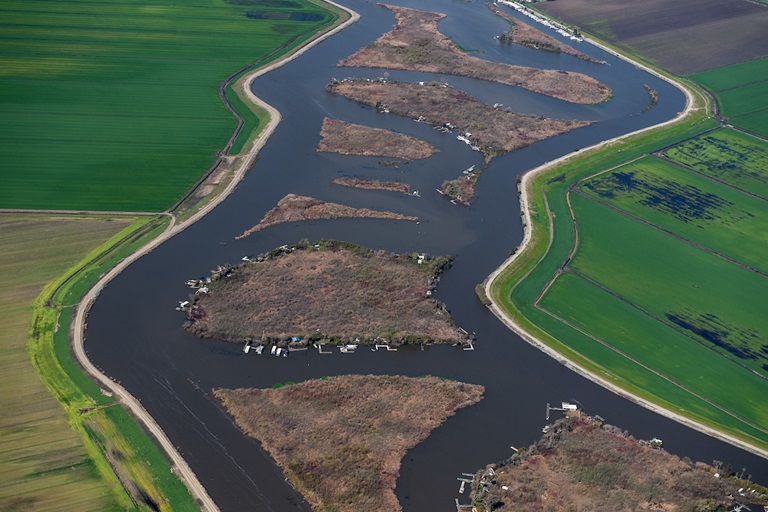Q/A: How would the proposed Delta Conveyance Project address climate change in California?
Aerial view looking east White Slough center, left is Rindge Tract and right is King Island, all part of the Sacramento-San Joaquin River Delta in San Joaquin County, California.
In the third episode in the Delta Conveyance Deep Dive video series, we asked DWR climate change experts to explain the ways in which the Delta Conveyance Project addresses the challenges of a warming climate.
State climatologist Michael Anderson joined DWR as a river forecaster in the Division of Flood Management in 2005 and continues to work with the Hydrology and Flood Operations to this day. His current position is a collaboration between DWR and the National Oceanographic and Atmospheric Administration (NOAA).
John Andrew is Assistant Deputy Director of the California Department of Water Resources. Since 2006 he has overseen DWR’s climate change activities and is the department’s representative to the Governor’s Climate Action Team. He supervised the development and implementation of DWR’s Climate Action Plan, served as an Associate Editor of California’s Fourth Climate Change Assessment, and in 2017 was appointed to the State’s Climate-Safe Infrastructure Working Group.
The conversation was moderated by Patricia Clark, Associate Governmental Program Analyst in the Delta Conveyance Office. Watch the full interview.
Let’s start with the basics. Mike, what is climate change?
Michael Anderson: Climate change, as we’re experiencing, is a warming planet. Temperatures are getting warmer and we see this in our data of annual average temperatures, each year of late being in the warmest edge of the distribution of temperatures we’ve recorded since 1895. This is caused by the increase in greenhouse gases. Greenhouse gases are in the atmosphere, and they work much like a greenhouse does to keep your plants warm. It lets sunlight in but doesn’t let the heat escape.
What are some of California’s unique climate characteristics?
MA: California is located in a fantastic place on the planet. We occupy 75 percent of the Pacific Coast of the lower 48 states. We have a fantastic range of rainfall totals from the southeast deserts, which get on average of less than five inches a year, to the temperate rainforests of the north coast, which can get over 120 inches a year. Year to year we experience more variability in our precipitation total outcomes than anywhere else in the lower 48 states. California's topography plays an important role. We have weather systems that come off the Pacific Ocean and include atmospheric rivers, or narrow bands of water vapor, that get pushed up against the mountains, leading to heavy precipitation in particular locations. As the world gets warmer, we actually see a change in that distribution of rain and snow. We see snow falling at a higher elevation, which then builds up our seasonal snowpack as limited to a smaller area of the mountains. This changes the way runoff happens to where we have more of the runoff from the rainstorms during the storm event itself, creating a flood hazard, potentially, and leaving less to run off in the spring [for] use in the dry summers.
The other aspect of that is that as that wet season is limited more to the wettest storms, we find that the rainiest days get wetter with more dry days in between and this will lead to a longer dry season with higher temperatures bringing more heat, drying out the landscape even more.
John Andrew: The challenge confronting water managers in California is more uncertainty, and the natural response is a portfolio of approaches. The governor has, as you know, a Water Resilience Portfolio, and the Delta Conveyance is one of the key parts of that portfolio to respond to climate change.
What is the major takeaway for DWR regarding how it manages water resources for California?
JA: I think the major takeaway is that a fundamental tactic in response to climate change is flexibility. The conditions that Mike described, are going to lead again to more uncertainty of when water shows up and when it's going to be there, what its quality is going to be, how it's going to interact with ecosystems and habitat. The ability to move water when water is available is going to be an incredibly valuable option for the state, whether that's to move water directly to users, move it into storage, either above ground or to recharge many of our great aquifers around the state.
